Working from home all day means I’ve become accustomed to the various sounds coming from my chickens in the backyard.
There’s the egg song, which they trumpet upon a successful lay. There’s the cooing chatter as they happily scratch and peck at the dirt. There’s the homing squawk when one of them suddenly realizes she’s alone, and the frantic flap of wings meant to shoo the neighborhood cats as they dart across our garden.
Then there’s an entirely different sound I’d never heard until recently, a cross of the homing squawk and a stuttering siren, a definite distress call that told me something was not right.
I ran into the yard and immediately Kimora, my Barred Rock, flew up to me in a frenzy. My Golden Laced Cochin, Iman, was nowhere to be seen.
I called for her as I made my way down the terraced property, peeking behind her favorite hideouts. She’s usually slow to answer my calls, but never this slow.
As I was approaching the property fence, I saw a feral black cat scamper across the path. Were the chickens raising a ruckus because of that thing? Cats, rats, and other small creatures had never bothered them before.
But suddenly, out of the corner of my eye, I saw a large gray cat leap out from behind a pile of bricks we’d stacked against the fence.
Only it wasn’t a cat.
Standing only a few feet away was a black-masked bandit eyeing me defiantly. It was the biggest and fattest raccoon I’d ever seen, and in its mouth was a tuft of black and bronze feathers.
My blood started boiling as soon as I realized what had happened. Protective instincts kicking in, I picked up a few lemons that had fallen off a nearby tree and started chucking them at the raccoon one by one.
I was furious, frightened, and stunned that this raccoon was roaming so freely in the middle of the day. I managed to chase it off, claws scratching up and over the fence.
With my heart still racing, I started searching for Iman, or what was possibly a carcass at this point. Not less than a minute after the intruder scurried into the street, an explosion of feathers shot out from under a rickety old stool.
It was a chicken! And much to my relief, she still had her head and all other body parts intact.
As I later discovered, Iman had taken shelter under the stool when the raccoon came around. (I should explain that this lower section of our yard looks like an episode of Hoarders, with several stacks of bricks, wood, furniture, and other knickknacks set aside for future projects.)
The stool, with its multiple legs and crossbars, offered her just enough protection from the raccoon before I startled it.
It appeared that the raccoon had managed to take hold of her wing, either with its mouth or its hands, but not with the force necessary to pull her away. It did, however, yank hard enough that one wing was visibly hanging lower than the other.
Since she was still responsive to us, and a manual check of her wing indicated no parts out of place or bones puncturing the skin, we concluded that she’d sprained, strained, or dislocated her wing in the attack.
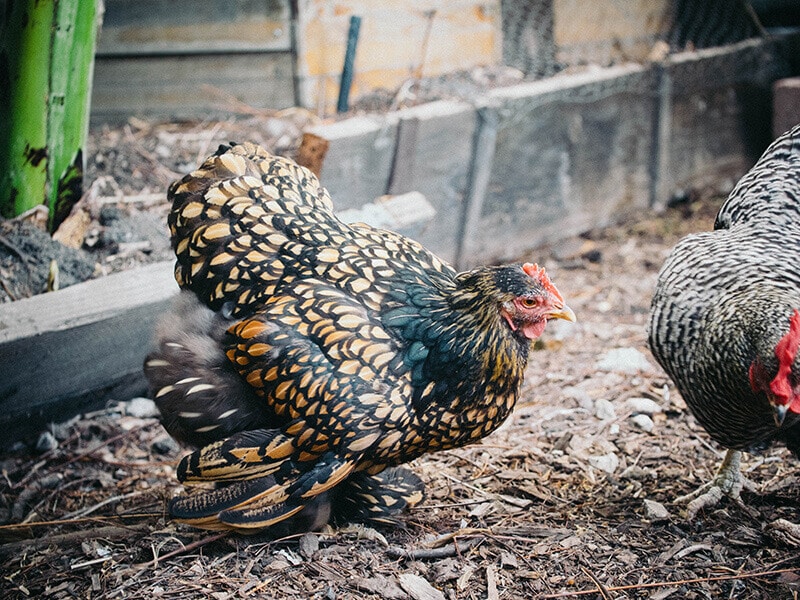
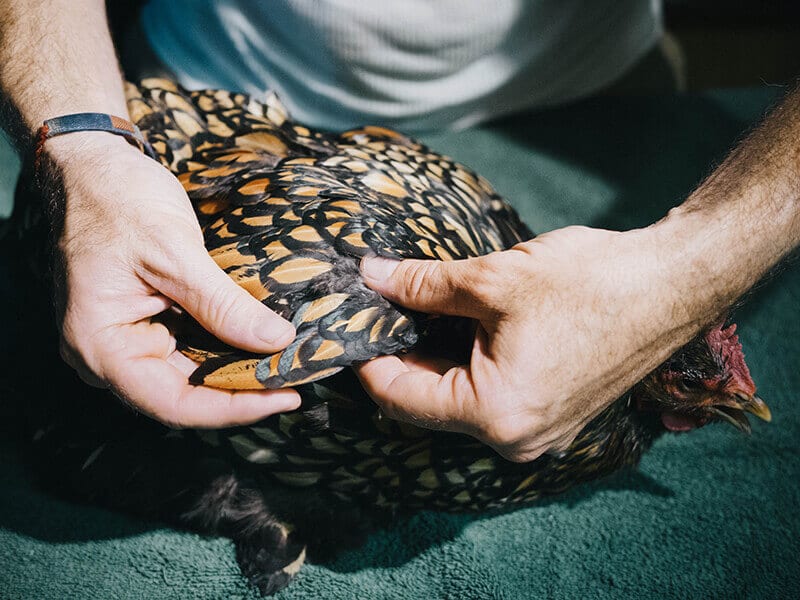
Iman was a very, very lucky girl. Her wing was drooping, but still somewhat mobile. We needed to restrict her movement so the sprain could heal quicker.
Disclosure: If you shop from my article or make a purchase through one of my links, I may receive commissions on some of the products I recommend.
Treating this type of injury at home requires nothing more than a wound cleanser and a bandage.
Disclaimer: Graphic images of wound below.
We used Vetericyn, an antibiotic-free cleanser that helps with skin irritations, and Vetrap, a flexible bandaging tape that adheres onto itself. A roll of medical tape ensures everything stays put.
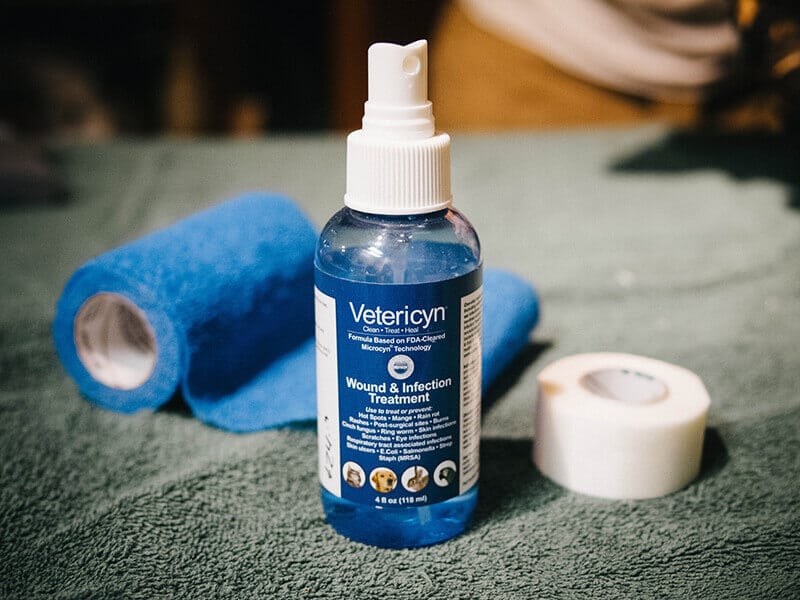
After the attack, Iman’s wing became highly inflamed.
She was in the middle of her molt, and the raccoon managed to pull out several pin feathers (immature feathers), leading to a very bloody swollen bump under her wing at the joint.
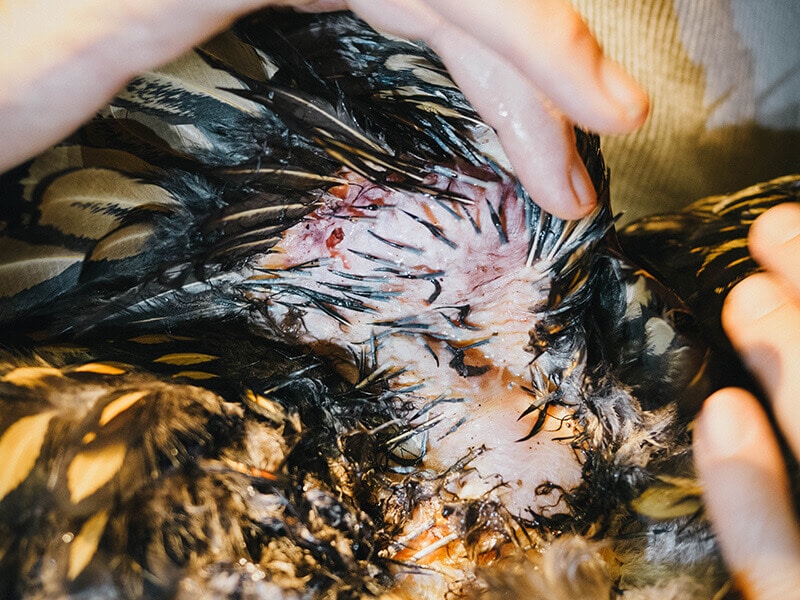
Not wanting to disturb the area any further, we simply wiped the blood off with a damp towel, then sprayed it liberally with Vetericyn until the skin and surrounding feathers were thoroughly wet.
As Will held her still on the table and kept her calm, I prepared the bandage.
If you have a wide roll like I do, you can cut it in half before wrapping; I find that a width of less than 2 inches is easiest to work with.
I also wrapped the wing with two separate lengths of bandages to prevent tangles. (The bandages were joined with tape in the middle.)
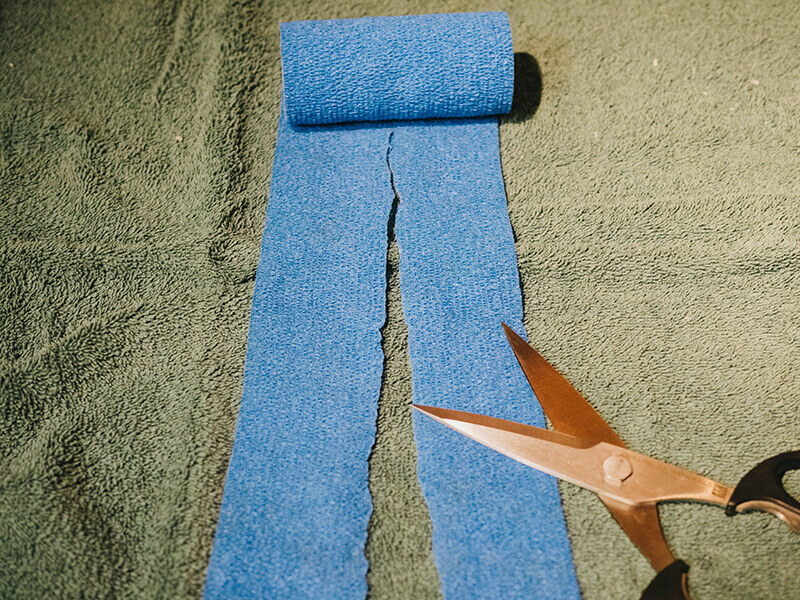
Starting from her lower back/tail area, we wrapped the bandage diagonally across her back and over the injured wing, making sure the bandage was snug enough to set the wing in place, but not so much that it cut off her circulation.
Then the bandage went around her chest, under the other (uninjured) wing, across her back, and around her chest again.
We repeated this wrap a couple more times until we reached the end of the bandage, then pressed it down into place.
With the second bandage, we pressed that over the first bandage, secured it with tape, then repeated the wrap again for a good, tight fit.
An extra piece of tape over the top held it all in place.
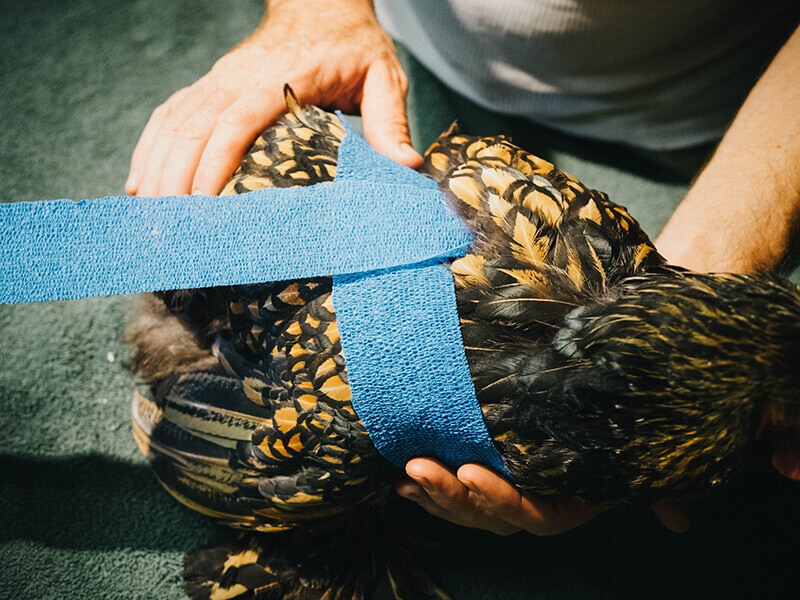


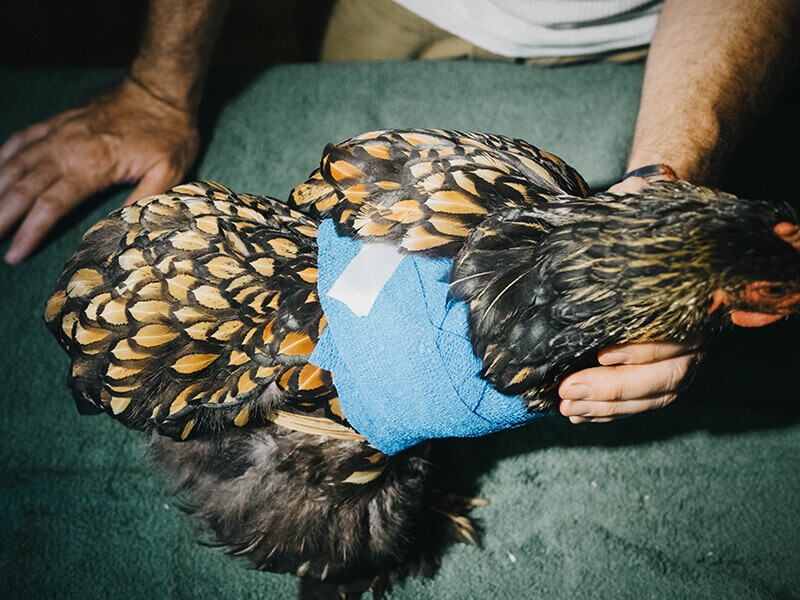
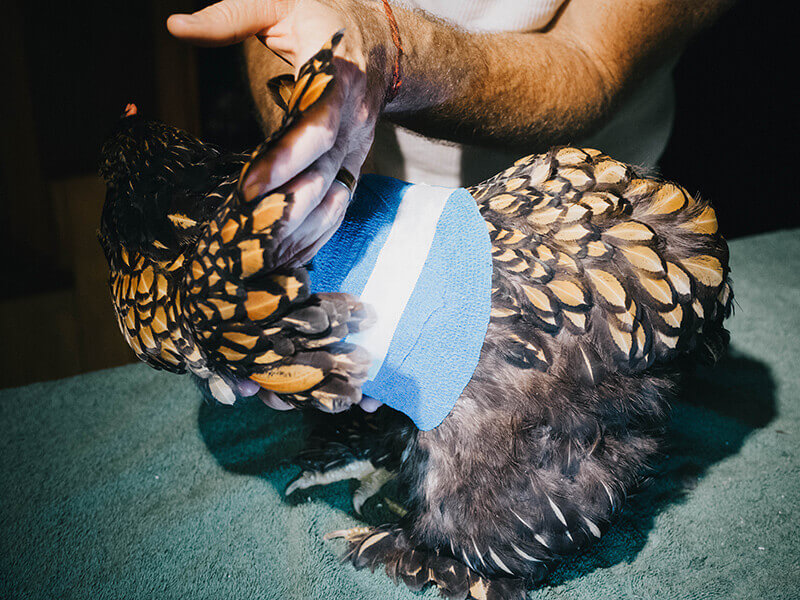
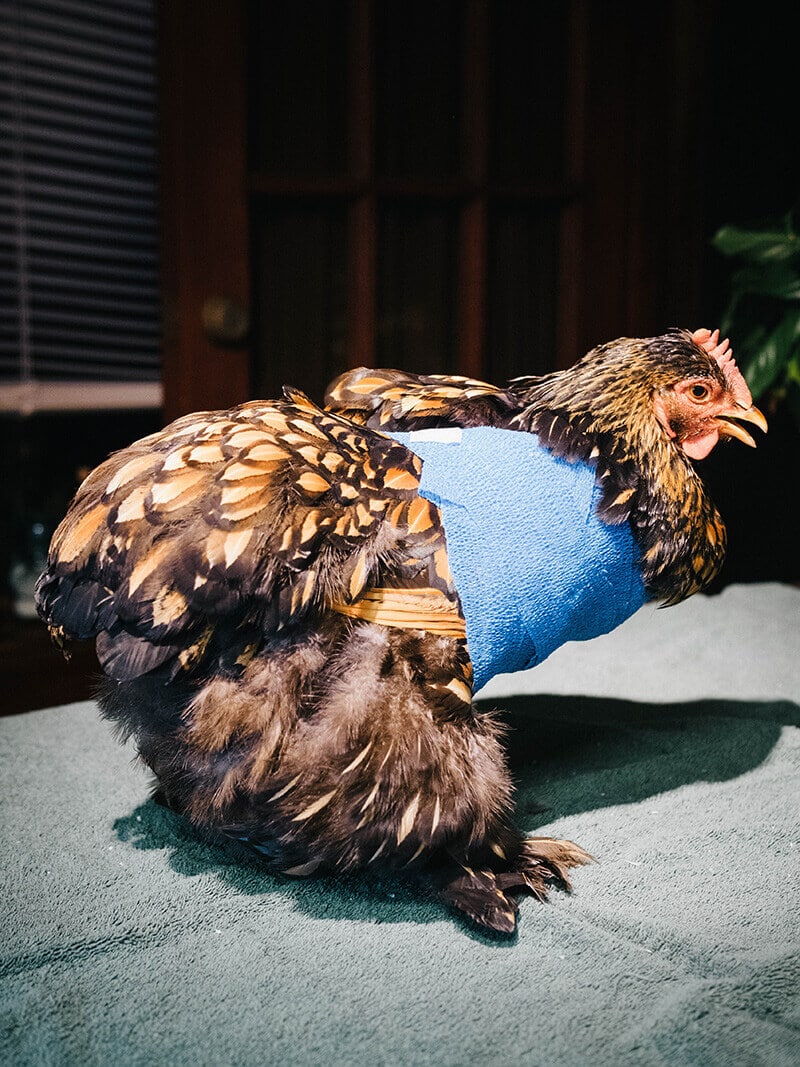
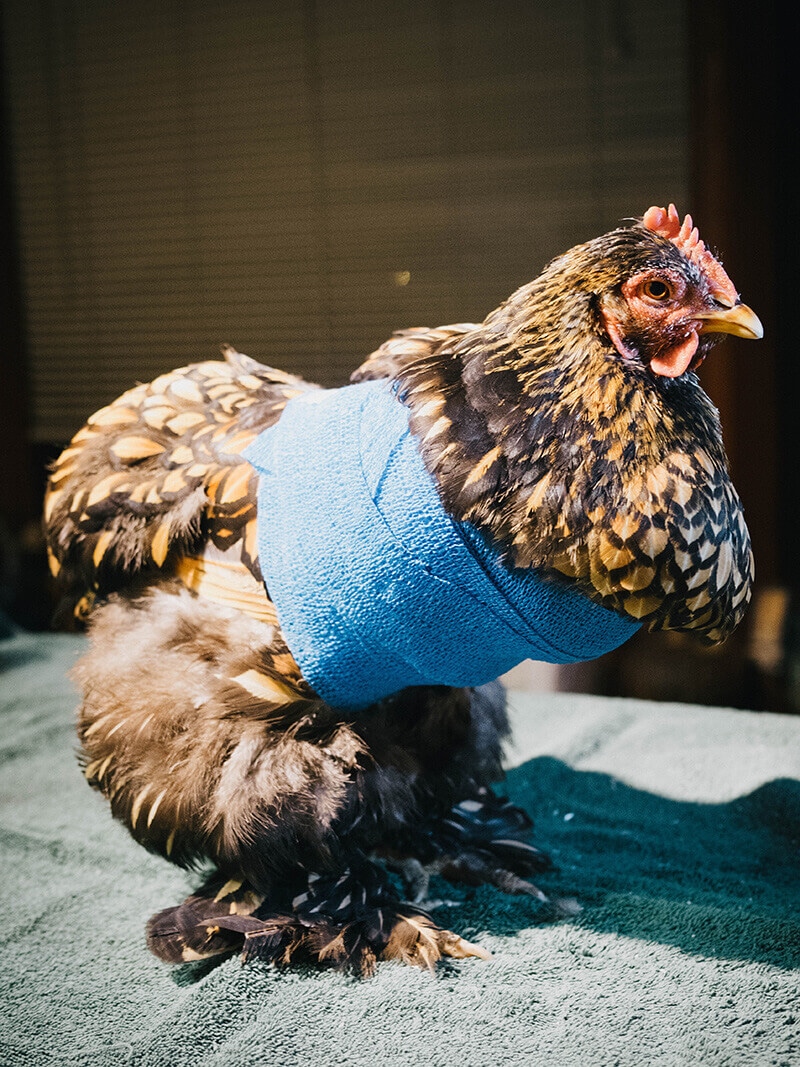
By the time we were finished wrapping, the injured wing was firmly set against her body, and the other wing was left loose and free to flap.
It looked a little strange at first, as all the chest feathers were puffed out, but Iman was still standing and walking around in all her one-winged glory.
Two important things we made sure to check: the bandage was not too tight around her crop in a way that compressed it, and the bandage was not covering her vent or interfering with her legs.
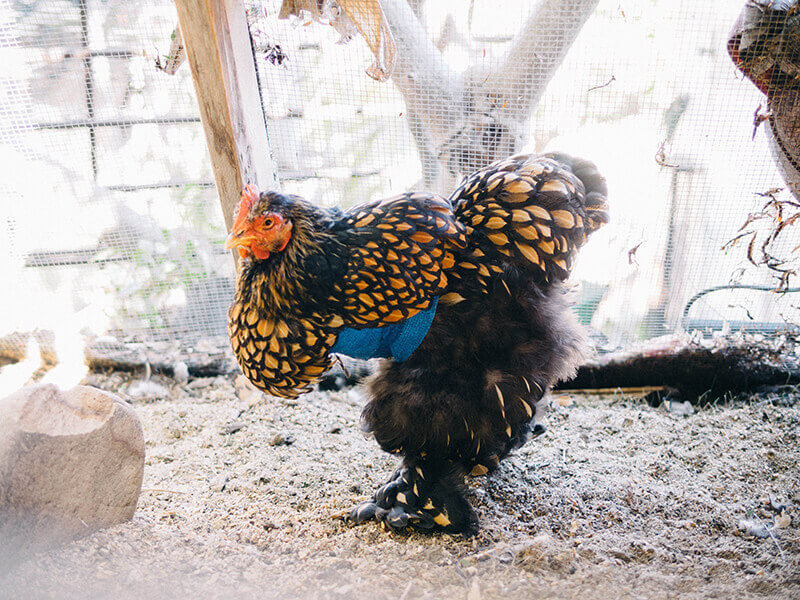
We left the wrap on for three days.
During that period, we found that she had trouble roosting, as she tended to use her wings to flap up to the bar at night. (Hopping down, however, was not an issue.)
We helped her onto the roost every night and watched her carefully every day for any abnormal behavior, such as refusing food or water.
Despite her injury, she was in good spirits and continued scratching in the dirt and chasing after treats.
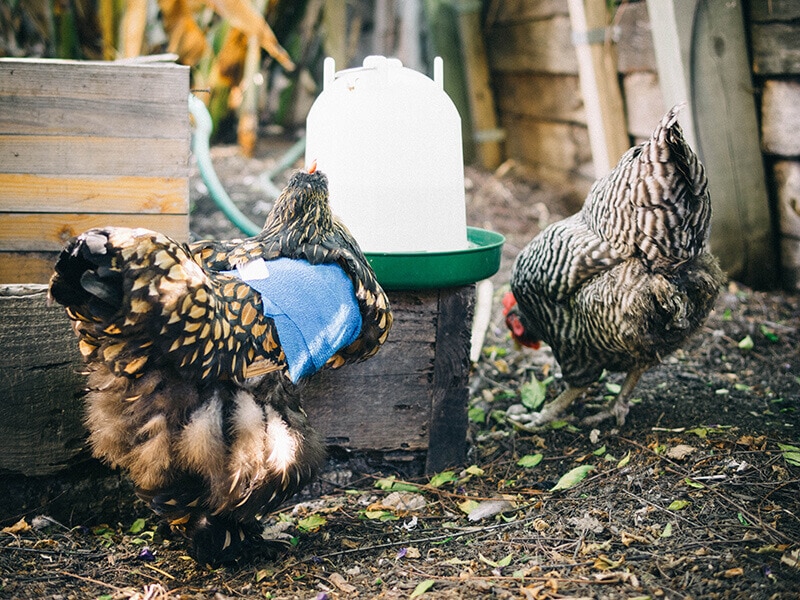
On day three, we decided to unwrap the bandage and take a look at what was going on under her wing.
And what we found was alarming! (At first…)

The swelling had subsided, but in its place was skin tinged an unusual green.
Not gangrene (which would emit a foul odor — yes, I sniffed the wing to be certain) but a bruise. A rather big bruise, its green color intensified on a chicken’s yellow skin.
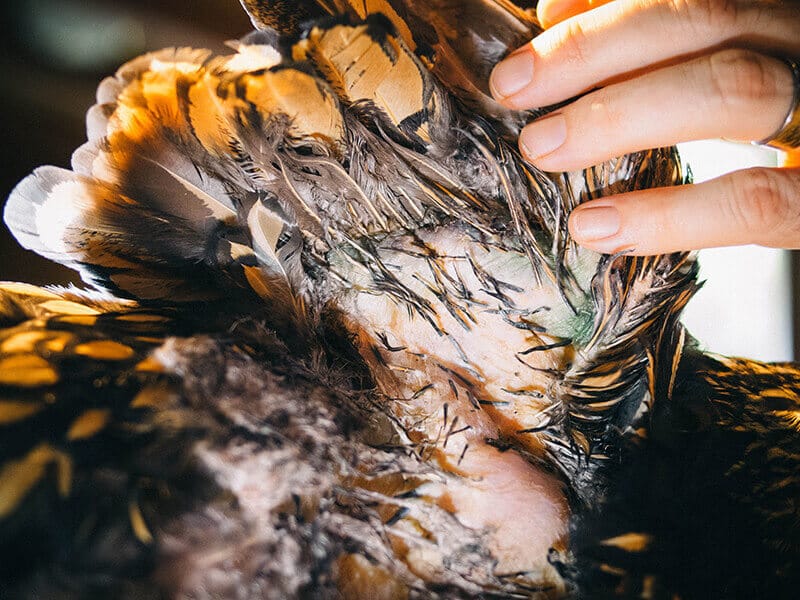
Since this was a sign of the skin starting to heal, we flushed the area with water (using the handheld sprayer on our sink faucet), cleaned the matted feathers, and gave Iman a good blow-dry.
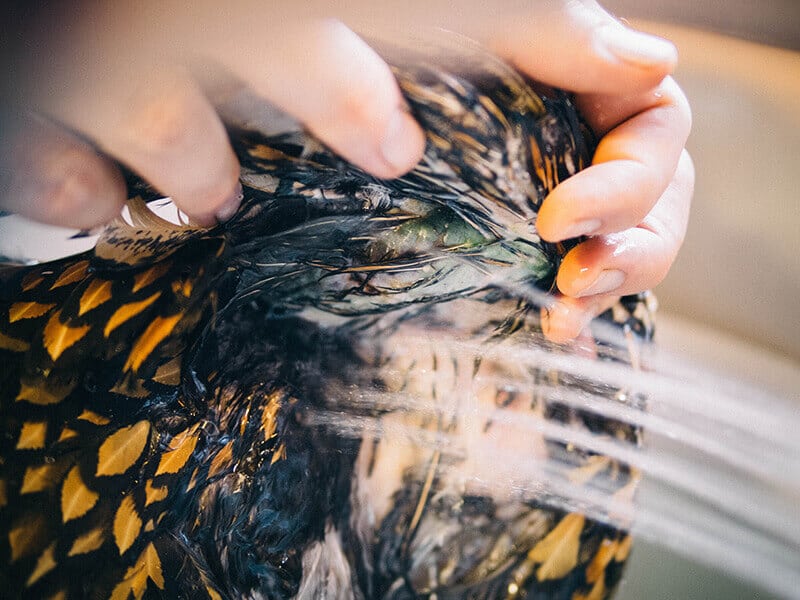
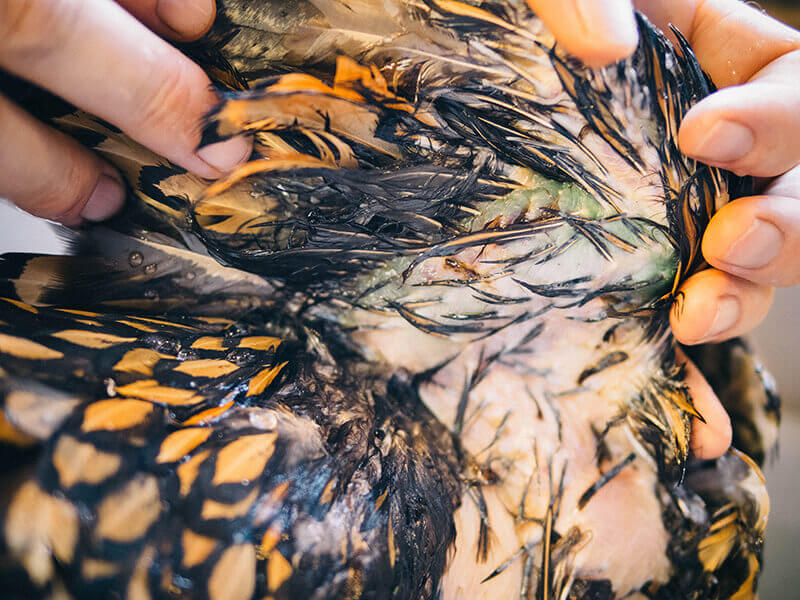
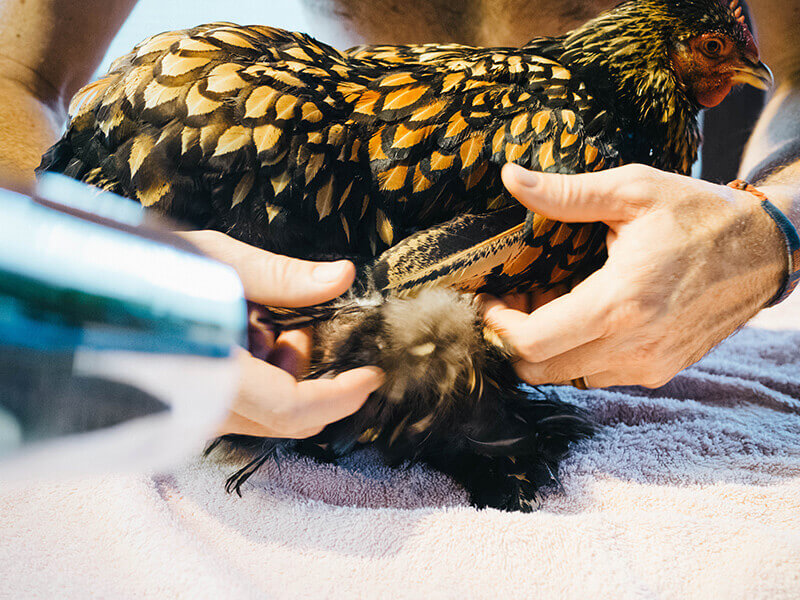
Her wing looked and felt better already — slightly more lifted, no swelling, and no lacerations that we could see as we were able to do a more thorough examination.
She was anxious to preen under her injured wing, and we figured it could only mean recovery was close.
We sprayed some Vetericyn on the bruise as a precaution, then rewrapped her wing.
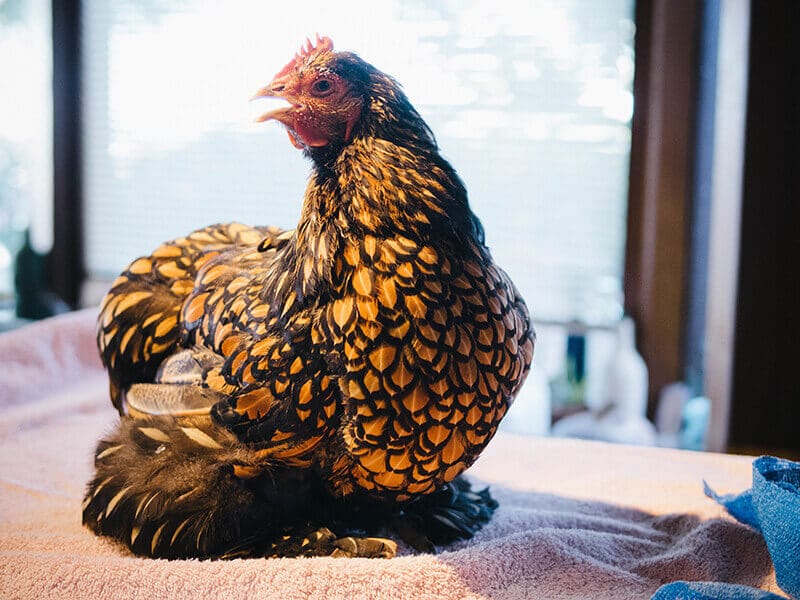
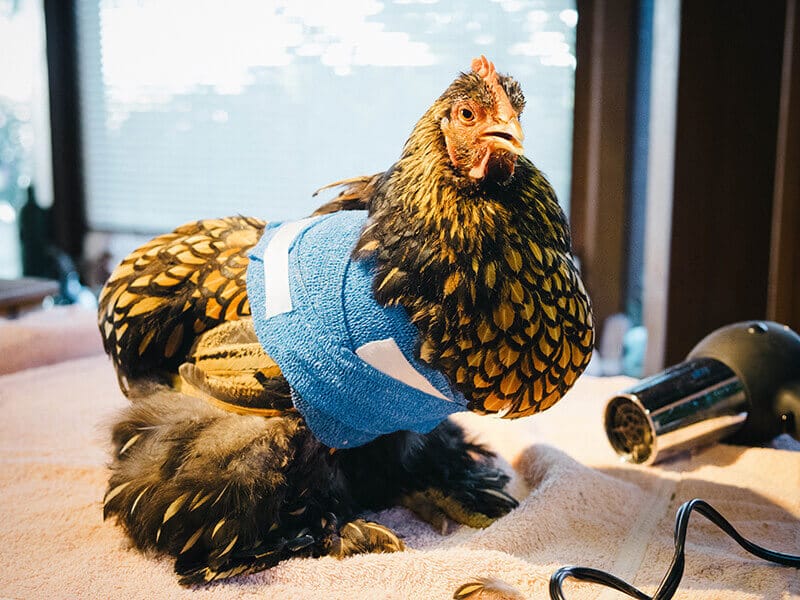
The wrap stayed on for another three days. When we removed the bandage, the green discoloration had faded.
We let Iman roam freely and while she still had trouble roosting, since her wing was not yet fully mobile, she seemed like her normal self.
Over the next week, her wing appeared stronger and stronger. The tip eventually stopped dragging on the ground and she molted the rest of her feathers.
By the end of week three, we could barely spot the site of injury; her new feathers had grown in and she was able to flap her wing again, albeit cautiously.

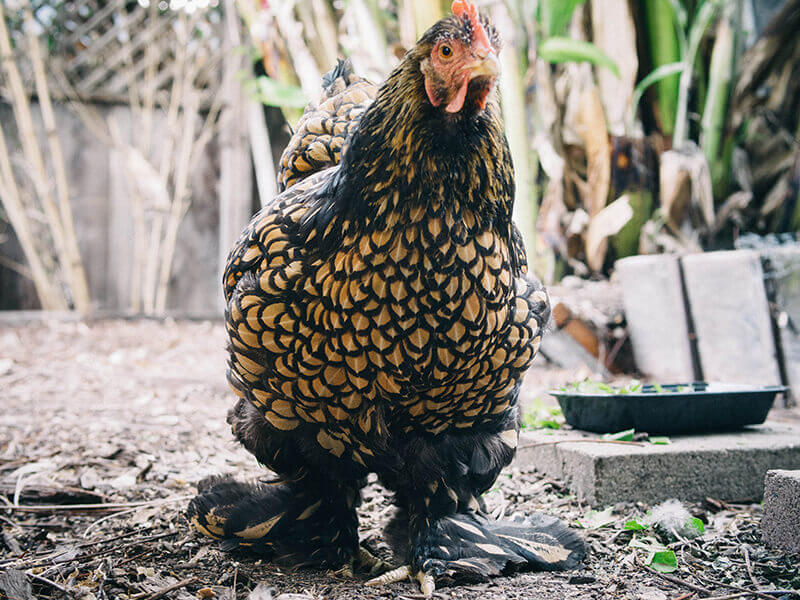

Five weeks after the attack, she’s close to 100 percent healed. She doesn’t flap as fervently as she used to (this is a chicken that could boost across the garden when I showed up with a handful of mealworms), but every day she seems to regain more of her strength and self-confidence.
Given a few more weeks, I have faith that our little Iman will feel brand-new!


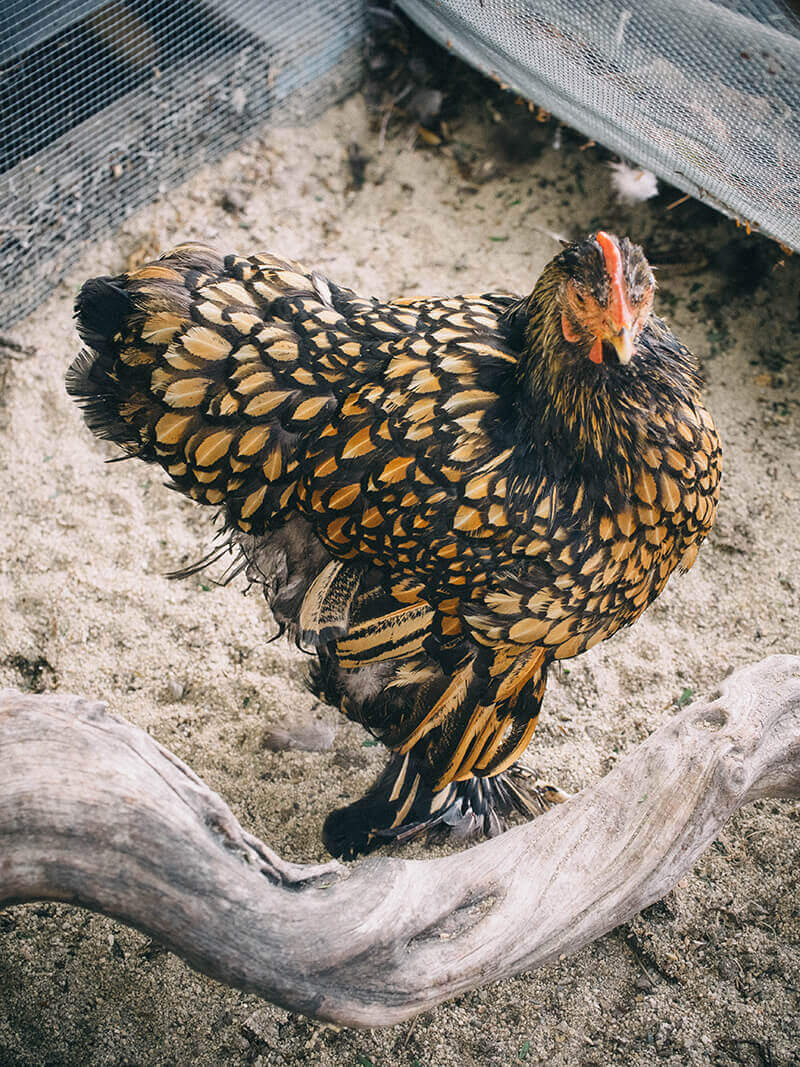













Thanks for posting! I didn’t have any wrap bandages to use so I cut the bottom leg off a pair of sweatpants and carefully pulled that over her sprained wing, carefully removing the uninjured wing and it is working fine to hold her wing gently against her body. Happy to be able to help a feathered friend!
Thank you so much! We have an injured hen now from a rooster that has grown too big and got roo rough with her. We’re going to treat her now, and unfortunately, wevhave to rehome the rooster to a sanctuary we’ve worked with in the past. I hope our hen, Whiskey heals as well as the other commenter,
This was an excellent post! Just what I needed. My New Hampshire Red rooster received a strained/dislocated wing while fending off the mask bandit until I arrived. It was the next day before I noticed, saw your post yesterday evening, and very much looking forward to the healthy return of Big Red.
Good luck to your little guy!
I know this was awhile ago for you, but it just happened this week to us. A coyote attacked my girls, luckily I got it away but not before my golden-laced Wyandotte lost her tail and was wounded. Her lacerations healed quickly but her wing is dragging. I think it is the same sprain you describe. Thanks for your detailed remedy!
You’re welcome! And as an update, our Cochin has been doing great since that attack a couple years ago. Hope your girl recovers smoothly.
Irene Ascencio Azahar liked this on Facebook.
Tips for treating a minor injury at home. Chicken First Aid: How to Wrap a Sprained Wing https://t.co/Z08IQ9Mh04 https://t.co/iLosYvL4Pj
RT @gardenbetty: In the aftermath of a raccoon attack… Chicken First Aid: How to Wrap a Sprained Wing https://t.co/WbualKGLFz https://t.c…
In the aftermath of a raccoon attack… Chicken First Aid: How to Wrap a Sprained Wing https://t.co/WbualKGLFz https://t.co/xtIfZHf6Ar
Deb Neyens liked this on Facebook.
If you raise #backyardchickens, this is a good guide to bookmark. Chicken First Aid: How to Wrap a Sprained Wing https://t.co/AttEs0yWOp
Chicken First Aid: How to Wrap a Sprained Wing https://t.co/YXDuZKjnyg
So glad she is okay. Raccoons are horrible things. My dog got into a fight with one early one morning a couple of weeks ago. The raccoon was hanging around outside the chicken pen, but the girls were still locked in their coop. Lucy (the dog) had a few bites and scratches, but after a trip to the emergency vet to get her wounds cleaned and a course of antibiotics, she is fine. She wasn’t going to let anything get to her chickens!
Thanks for sharing your story and your useful tips on chicken first aid.
Raccoons are quite vicious, especially the city raccoons we deal with! I hear their run-ins with cats a couple nights a week in our neighborhood.
Thanks for sharing this, I have four chickens and thank goodness they have never been injured. I will save this post.
It can be a little scary when something like this happens to the flock! Maternal instinct definitely set in for me!
Beth Pappadopoulas Abate liked this on Facebook.
Oh my! Raccoons are so vicious! Poor girl. I I had never thought about wrapping a chickens wing like that. I will be investing in some of that tape. Thank you for all the good information you blog!
You’re welcome! I’ll be writing about the importance of stocking a basic chicken first aid kit soon.
Greg Towne liked this on Facebook.
Maria Pomeroy liked this on Facebook.
Marcia Holtsclaw liked this on Facebook.
Laura Kassler Gaines liked this on Facebook.
Dripworks liked this on Facebook.
A step-by-step guide on setting a wing and helping it heal. Chicken First Aid: How to Wrap a Sprained Wing https://t.co/vWvlLIDQLr #poultry
RT @gardenbetty: Learn to treat an injury at home. Chicken First Aid: How to Wrap a Sprained Wing https://t.co/tltMwjRUBe #poultry https://…
Oh my goodness, that poor girl, and poor you too! So glad she is doing better. Brilliant wrapping technique. Good job! We had a fox attack and after scaring the critter away, our hen was badly torn superficially. Thankfully, we were able to clean with peroxide and Neosporin (love your recommendation of spray antibiotic, thanks!) and then sewed her up with dental floss! She healed beautifully, and we lived to tell the tale. Amazing what those girls can withstand. So happy all went well for you! Know how you feel about those girls! 🙂
Thankfully, they are quite resilient and brave! Iman is already starting to venture back down to the scene of the accident! (I, of course, am incredibly nervous that we’ll run into the raccoon again.)
Poor, beautiful girl to have to go through that. You guys did right by her. Passing along your tips and blog to all my chicken parent friends.
Thank you Cherryl, I hope this story is useful to anyone else who might have this experience in the future. (But hopefully not!)
Learn to treat an injury at home. Chicken First Aid: How to Wrap a Sprained Wing https://t.co/tltMwjRUBe #poultry https://t.co/uVBKb4yRMT
Lucky girl! Great tips on how to treat an injury. Sharing this morinng with my readers. So glad she’s going to be okay.
Thanks Lisa!
Lydia Ann liked this on Facebook.
Lisa Hardi liked this on Facebook.
Greg Hadel liked this on Facebook.
Inés Bayona Masoliver liked this on Facebook.
Lauren Hayes liked this on Facebook.
Will Taylor liked this on Facebook.
Van Monk liked this on Facebook.
Blogged on Garden Betty: Chicken First Aid: How to Wrap a Sprained Wing https://t.co/yzZm7lhFDr